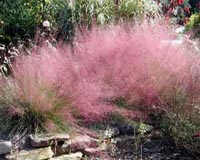Resource Library
Plant of the Week: Muhly Grass (Hairy Awn Muhly)
The University of Arkansas System Division of Agriculture does not promote, support or recommend plants featured in "Plant of the Week." Please consult your local Extension office for plants suitable for your region.
Plant of the Week
Muhly Grass, Hairy Awn
Latin: Muhlenbergia capillaris

A minivan full of Arkansas plant nuts just returned from a tour of southeastern nurseries where we beheld a toothsome assortment of new and interesting plants to try in our gardens. One of the most striking perennials we saw was muhly grass, Muhlenbergia capillaris.
Our collective heads were turned on a bright October day when we saw a mass planting of muhly grass backlit by the early morning sun. The delicate, wispy plumes shimmered an iridescent pinkish-purple that made even the most flamboyant flowers look tame by comparison.
Other ornamental grasses may get bigger and have more stature in the landscape, but none will present a more appealing display when the light conditions are just right.
More than 70 species of muhly grasses are described, with most of them native to the western parts of North America. Muhlenbergia capillaris, though, is native from Massachusetts to Florida and across to Texas and into adjacent areas of Mexico. In full plumage in the fall, it grows 3-feet tall with the panicle a third to half the height of the plant.
The plumes of Muhlenbergia capillaris are oval in outline and composed of thousands of delicate pinkish hair-like strands. The grass is perennial and forms a strong clump with round, rush-like leaves that are stiffly upright and usually less than 18-inches tall.
Muhly grass is named for Gotthif Henry Ernest Mühlenberg (1753-1815), who was the pastor of the Trinity Lutheran Church in Lancaster, Pa., and an avid amateur botanist. Plant people throughout history have let their interest in plants turn to passion and their passion turn to obsession. Herr Mühlenberg seems to be one of those people.
From his home base in southeastern Pennsylvania he collected plants and published on the native flora of his region. He was active in the natural history circles of his day and was considered the "Linnaeus of America" by some of his European corespondents. Meriwether Lewis gave Mühlenberg seeds of six western plant species collected on their epic tour and he lovingly grew them in his garden. His treatise on American grasses was finally published two years after his death.
In nature, muhly grass occurs in rocky or sandy sites in full sun amongst pines, along salty or freshwater marshes and in dry upland hardwood forests. It will tolerate temperatures as low as minus-15 degrees and is hardy throughout Arkansas. In much of the southeast it grows alongside roadways. Too often it’s mowed down before it’s delicate plumes appear in the fall. It does not seem to become weedy when planted in the garden.
In the garden it will grow in most sunny to lightly shaded sites as long as there’s sufficient soil drainage. It’s best used in mass plantings where the delicate texture of the blooms can be displayed unencumbered by surrounding vegetation.
For best display, put the plant where it can be seen in the early morning or evenings. The flat light of the noonday sun hides much of the beauty of the plant. A striking use would be to interplant clumps of muhly grass in a bed of groundcover juniper.
By: Gerald Klingaman, retired
Extension Horticulturist - Ornamentals
Extension News - October 26, 2001
The University of Arkansas System Division of Agriculture does not maintain lists of retail outlets where these plants can be purchased. Please check your local nursery or other retail outlets to ask about the availability of these plants for your growing area.